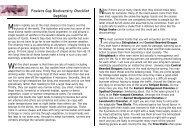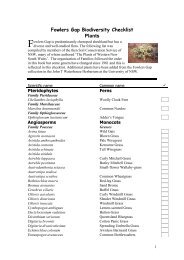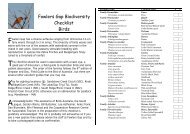2007 Research Reports.pdf - Fowlers Gap Arid Zone Research Station
2007 Research Reports.pdf - Fowlers Gap Arid Zone Research Station
2007 Research Reports.pdf - Fowlers Gap Arid Zone Research Station
Create successful ePaper yourself
Turn your PDF publications into a flip-book with our unique Google optimized e-Paper software.
sound artist Jane Ulman; Scientist and Director of <strong>Fowlers</strong> <strong>Gap</strong> <strong>Research</strong> <strong>Station</strong>, Dr David<br />
Croft; Director of the Broken Hill Art Exchange, Susan Thomas and Indigenous Elders Mark<br />
Sutton, Chairman of the Mutawintji Land Council and Badger Bates, artist and elder of the<br />
Barkanji Nation.<br />
A group of COFA Post graduate students also attended.<br />
Questions that arose from the symposium include:<br />
▪ How can art contribute to ecological, cultural and economic sustainability in an increasingly<br />
arid and [stressed] environment?<br />
▪ How can art become an intermediary between scientific endeavours and community<br />
involvement in, and acceptance of, change?<br />
▪ Can art act as conduit between scientific research and community awareness?<br />
The Potential Establishment of an Interdisciplinary <strong>Research</strong> Team<br />
As a result of the symposium ILIRI is proposing the establishment of an interdisciplinary<br />
research team across the disciplines of Art, Science and Architecture.<br />
According to the <strong>2007</strong> YASMIN_ADA Art and Climate Forum, sponsored by the Arts/Science<br />
Journal Leonardo, ‘Science could be considered to have a public relations problem. “In the book<br />
Making Climate Forecasts Matter the scientists Stern and Easterling admit, “…research<br />
addressed to questions framed by climate science is not necessarily useful to those whom climate<br />
science affects” (Easterling, 1999:3). Results from a UK poll published through the Guardian<br />
(July <strong>2007</strong>) found that the public is highly informed about climate change, yet most people are<br />
still skeptical about the seriousness of the threat…. We have reached an impasse where there is a<br />
high level of public awareness about climate change, indeed an over saturation, yet there is no<br />
corresponding mass action or direction.’<br />
There are already strong links between the arts (I use this term broadly to include architecture<br />
and design) and science. Art has been considered as a positive mediator between science and the<br />
general public, predominantly because the arts is capable of using a “language” that is more<br />
accessible to the public.<br />
“Despite the fields of environmental conservation and the creative arts having much to offer each<br />
other, mechanisms for building meaningful bridges between them are still undeveloped”<br />
(D.Pritchard, Art and Environment – Relating the creative arts to environmental conservation.<br />
Landscape and Arts Network Online Journal, No. 38, August 2006).<br />
Aim of potential Collaboration<br />
Through a team of artists, architects and scientists the aim of this research investigation will be to<br />
develop and apply interdisciplinary, creative research to the design and implementation of<br />
ecologically sustainable and humanly sustaining (pleasing to the eye and the soul) semi-arid<br />
environments. This could form the basis of a ‘program’ that extends for a 5 year period and that<br />
funds a series of investigations that are logically related to each other and that demonstrably<br />
produces insights that can be generalised and applied elsewhere.<br />
As UNSW owns the <strong>Fowlers</strong> <strong>Gap</strong> <strong>Research</strong> <strong>Station</strong>, an area of land could be set aside in this arid<br />
environment for the investigative team to conduct this research. This would become the “creative<br />
laboratory” where artists, architects, scientists, (agriculturalists, botanists, land use planners,<br />
geographers, anthropologists, ecologists, geologists, hydrographers etc) could collaborate in






